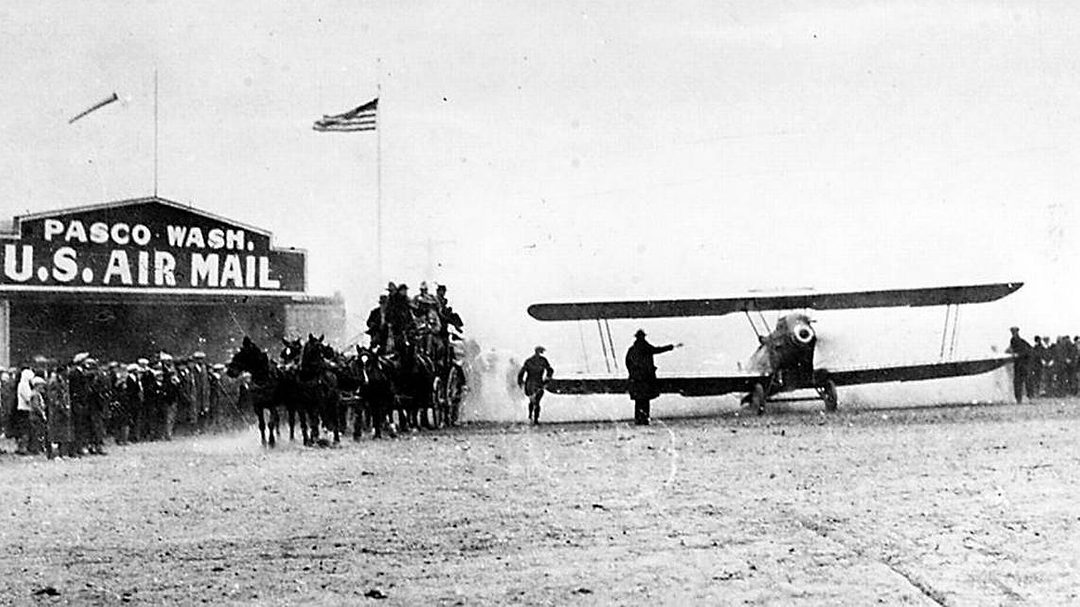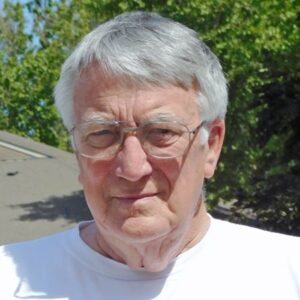
Home » Thousands turned out for first commercial airmail flight 98 years ago
From stagecoach to biplane
Thousands turned out for first commercial airmail flight 98 years ago

Pasco celebrated the first air mail delivery when pilot Leon Cuddeback took off from Pasco Airport bound for Elko, Nevada, on April 6, 1926.
Courtesy Franklin County Historical MuseumApril 1, 2024
Felix Warren drew his stagecoach, carrying 207 pounds of mail, up to the Pasco hangar. He nestled his team of horses beside the open cock-pitted Laird Swallow biplane to unload the mail sacks it had taken him five days to transport from Spokane on the coach pulled by his six horses.
Warren’s mail and other cargo would soon be 400 miles away – in a matter of just hours, not days.
The first-ever airmail service from the Tri-Cities – and the first ever civilian-contracted airmail service in the United States – began that morning 98 years ago on April 6, 1926.
Leon Cuddeback, who went by “Lee,” flew his biplane between Pasco and Elko, Nevada, that Tuesday morning, flying for Varney Air Lines, and carrying mail destined for Boise, Elko, San Francisco, Salt Lake City, Chicago and points beyond.
Six mailbags were bound for New York City and some for foreign countries.
Parcels aboard the plane included bottles of grape juice from the area, destined as a gift to President Calvin Coolidge and Gov. Al Smith of New York. In 1928 Smith was the Democrat Party nominee for president who lost to Herbert Hoover.
The Kennewick Chamber of Commerce sent along a box of asparagus for Harry New, the U.S. postmaster general.
The Pasco ceremony for the first airmail flight included a squadron of planes from the 116th Observation Squadron of the Washington National Guard, which flew in for the ceremony.
The crowd estimates ranged from 2,500 to 6,000 visitors to witness Cuddeback’s flight into history that April morning.
Airmail takes off
Walter T. Varney, who had been a pilot for the U.S. Army Signal Corps in World War I, founded Varney Air Lines, headquartered in Boise, Idaho. He received one of the first designated-route airmail contracts given to a private airline by the postal service. Varney Air Lines has been described as a precursor to United and Continental airlines.
In 1925, just a year before Varney’s contract, Congress authorized contracts for airmail service with private airlines.
The U.S. government was operating its own transcontinental airmail service between San Francisco and New York, and some of the contracted routes connected with it.
Interest in airmail service was not long in coming after the Wright Brothers made history with their first flight at Kitty Hawk, North Carolina, on Dec. 17, 1903.
The nation’s U.S. postmaster general under President William Howard Taft was Frank Hitchcock, serving from 1909-13, and he was enthusiastic about the idea.
The first-ever airmail flight in the U.S. was on Sept. 23, 1911, piloted by Earle Ovington and his Bleriot monoplane.
Two years later in 1913, Katherine Stinson, a 22-year-old aviator, became the first woman to deliver U.S. mail by air. Like Ovington’s delivery, her mail was dropped from the plane while flying overhead and picked up by postal authorities on the ground.

Katherine Stinson
| Courtesy Wikimedia CommonsPasco's historic flight
Cuddeback lifted off the ground at 6:20 a.m. in Pasco for a first-leg stop in Boise, Idaho. Arriving there about three hours later, he was greeted by enthusiastic large crowds like those in Pasco. He dropped off mail and departed Boise with new sacks 48 minutes later.
He arrived in Elko at 12:38 a.m. Pacific time, six hours and 18 minutes after leaving Pasco. His actual flying time was four hours and 28 minutes. Delivery of mail by train from Pasco to Elko would have taken 49 hours.
Just before reaching Elko, he had been drenched by rain in his open cockpit while passing through a severe thunderstorm.
In completing the mission, Cuddeback became the first civilian pilot to ever deliver mail by air in the United States by contract with the U.S. government.
Other pilots actually were scheduled for the honor.
Joe Taff and George Buck were flying together en route from Boise to Pasco the day prior to Cuddeback’s flight. They were scheduled to flip a coin in Pasco to decide who would make the historic flight to Elko.
But just before reaching Pasco, the motor of their plane died. They glided to the ground before nosing into a sand dune near Burbank, causing their plane to tip over. They received only minor injuries.
Gale Metcalf of Kennewick is a lifelong Tri-Citian, retired Tri-City Herald employee and volunteer for the East Benton County Historical Museum. He writes the monthly history column.
Senior Times
KEYWORDS April 2024
Related Articles




